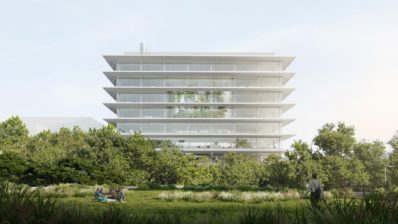For the third consecutive year, last Friday 15th of February, the 20 finalists of the 9th edition of the Olimpíada de Biologia de Catalunya – out of a total of 330 students enrolled this year in the competition – visited the Barcelona Biomedical Research Park (PRBB).
This “Biology Olympics” is an annual competition aimed at encouraging 17 and 18-year-old students to study biology. It consists of a test, divided into two different parts:
- Theoretical part: it is done by all of the enrolled students, which are assessed to ensure the assimilation of biology concepts.
- Practical part: it is only done by the 20 finalists, that is to say, the ones who did better in the theoretical part. In this practical part, the students need to solve two problems by designing some experiments.
Getting to know research first hand
The students arrived at the PRBB early in the morning, and attended a presentation of the park. Later on, they did a guided tour to understand the organization of the park and its history.
The group leader of the Neuromodulation of neural networks and circuits research group at the Institut Hospital del Mar d’Investigacions Mèdiques (IMIM), Vicky Puig, introduced the finalists to the neuroscience field. Specifically, she told them about the importance of neuronal connections at different levels: from brain rhythms during sleep, to neuronal hyper-synchronization in epilepsy. The scientist also answered some questions from the students.
This talk about neuroscience was followed by the second part of the day in which the students visited some of the most important services at the PRBB. In order to do that, they were divided into two groups.
On the one hand, Guadalupe Espadas, chemist and lab technician, showed the Proteomics service to the students. The scientist explained their daily routine at this service – a mixed unit of the Centre for Genomic Regulation (CRG) and the Department of Experimental and Health Sciences, Pompeu Fabra University (DCEXS-UPF) – and showed them how to understand the results they obtain from each experiment.
On the other hand, Montserrat Coll, doctor and mesoscopic imaging specialist at the European Molecular Biology Laboratory (EMBL), showed the mesoscopic imaging service to the students, telling them how this service works and what kind of experiments they perform.
After having lunch all together at the cafeteria of the PRBB, the students attended a ceremony in which the 5 finalists that will compete at the Olimpiada Española de Biología (the country-level competition where the best students from each region of Spain get together), were announced.
QuinteScience: an initiative promoted by former participants of the Olimpiada Española de Biología
The QuinteScience project finds its beginning precisely at the Olimpiada Española de Biología. This association composed by students and young researchers from Spain was created by former participants of this competition. Its main goal is science dissemination through talks, workshops and other activities.
For this reason, and after the first and second edition of the QuinteScience meeting at Oviedo and Zaragoza, respectively, the 15th, 16th and 17th of March 2019 they will hold the third edition in the city of Barcelona (III Encuentro QuinteScience). The participants will be able to visit some scientific infrastructures in Barcelona, such as the ALBA synchrotron or the PRBB, which they will visit on Friday 15th of March in the morning.







